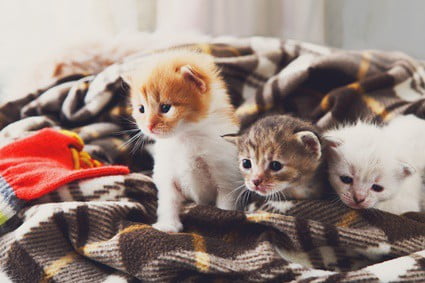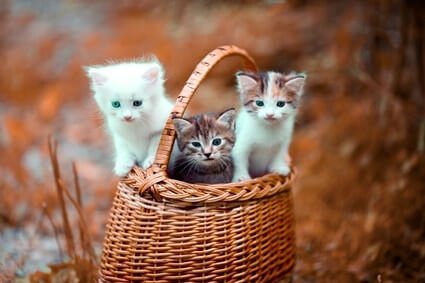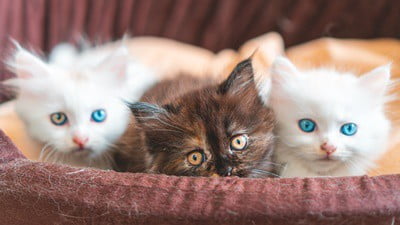Cats in the same litter can have different colors, patterns, sizes, and even breeds. The only explanation is that the kittens have different fathers.
Cat litters can have more than one father due to superfecundation. Female cats’ egg production is induced by mating. When the female produces multiple eggs and mates multiple times, the eggs can be fertilized by different fathers. The kittens are born in the same litter.
What makes this possible is the cat’s unusual way of reproducing. And what makes the process even more fascinating is that the litter can actually have more than two fathers.
Can Cat Littermates Have Different Fathers?
If the kittens in your cat’s litter look like different breeds, you may wonder if they have different fathers. While this sounds unlikely, it can happen due to a biological phenomenon called superfecundation.
To grasp how this happens, you have to understand the cat’s reproductive process. So, how can a female cat have a litter with different fathers?
What is Superfecundation?
Superfecundation means that two or more eggs have been fertilized in the same heat cycle. This can occur when the same pair mate multiple times during the cat’s heat cycle. It’s also possible for different fathers to fertilize each egg, which is known as heteropaternal superfecundation.
The term superfecundation comes from Latin; super means above or beyond. Fecund means fertile, so fecundation means fertilization. So, the term means after the first fertilization.
The female will produce several eggs, some of which are fertilized by the partner it is currently mating with. It can then mate with another partner soon after to fertilize the rest of the eggs. They are quite literally fertilized after the first fertilization.
This is advantageous from an evolutionary perspective. If its offspring with one parent is unviable, then the offspring from the other parent won’t be affected by the same genetic issue.
Superfecundation in Cats
To fully understand how superfecundation works, you have to understand how cats mate.
Cats can’t have kittens any time that they like. They are seasonally polyestrous, which means that they come into heat. This is a period of time when the cat can ovulate (produce eggs that can then be fertilized.)
Crucially, the way a cat produces an egg is different from other animals. Cats only release eggs from their ovaries when they mate. The term for this is induced ovulation; it makes the mating process more likely to be successful.
Other animals produce eggs on a regular cycle. Reproducing this way isn’t as effective because mating outside of this cycle means there is no egg to fertilize.
Repeated Mating and Superfecundation
Once the eggs are released and the cat mates, some of the eggs are fertilized. Once an egg is fertilized, it travels from the fallopian tubes (which connect the ovaries to the rest of the reproductive system) to the uterus.
Normally, an egg will disintegrate within 24 hours or so if it isn’t fertilized. Once a mammal has a fertilized egg, its body stops producing further eggs. That’s why female mammals don’t have periods when pregnant because they stop producing eggs from their ovaries.
Getting pregnant again halfway through pregnancy would interfere with the development of all the offspring. So, the body doesn’t allow it to happen.
The cat doesn’t stop being in heat once it mates. She can mate again within that 24-hour time frame, either with another tomcat or the same one. If the female released multiple eggs, and one of them isn’t fertilized yet, it may be fertilized by the second father. That’s how heteropaternal superfecundation occurs.
This can occur with more than two fathers. Theoretically, there’s no limit to the number of fathers that could have been involved in siring a litter. Cats are promiscuous and can mate several times in a short amount of time.
Can Cats Be Pregnant with Two Different Litters?
To be clear, the eggs aren’t somehow stored separately, one kept aside for later. Once an egg is fertilized, it heads to the uterus (the womb). Here, it attaches itself to the womb lining and begins to develop.
If another egg is fertilized soon afterward, it will do the same. It will head from the ovaries to the uterus, implanting itself in the uterine lining. It will then begin developing, too.
This means that the cat then has two litters developing in its uterus at the same time. This doesn’t necessarily mean that the overall litter will be twice as large. Genetically, they are two different litters.
These litters will develop at about the same pace and will be birthed at the same time. So, in a sense, they are two litters within one litter.

Why Do Cats from the Same Litter Look Completely Different?
Superfecundation can lead to kittens looking different from their brothers and sisters. In some cases, these differences are slight as they are in normal litters. However, you may notice more significant differences like different breeds or long hair vs. short hair.
However, kittens in the same litter can look different even if they have the same father. Even though they are born at the same time, kittens are only fraternal twins. This means that they have the same amount of shared genetics as regular siblings.
There’s still room for them to look different. Regular littermates can be of different colors and sizes and have completely different personalities. So, the fact that they don’t look the same isn’t proof enough of superfecundation.
Can Kittens Have More than One Father?
Despite superfecundation being real, that doesn’t mean that a kitten can have more than one father. One kitten can have three parents. This has been done artificially in a lab but is not observed in nature.
Animals have been created with 50% of the mother’s DNA, 50% of the father’s DNA, and a third party’s mitochondrial DNA. According to New Scientist, this was first done to assist parents with an obscure genetic condition.
Outside of science, the way that genes work dictates that only two animals can be a parent to one animal. According to the BBC, the only alternative is for an animal to produce offspring without a partner is through parthenogenesis.
This is impossible in nature and has nothing to do with superfecundation as a process. However, littermates can have different fathers. Like all animals, these kittens will still only have one father and one mother.
How Common is Superfecundation?
Superfecundation is extremely common in cats. According to the Royal Society, 83% of litters have more than one father. This can be proven by comparing the DNA of littermates to see whether they are full siblings or half-siblings.
However, according to the study above, the percentage may vary depending on where you live. A litter of a cat in the city is more likely to have more than one father (70-83%) because there are far more tomcats available for mating. There are fewer cats around in the country, so the proportion of litters with more than one father may be 0-22%.
Whether this phenomenon is common or not isn’t an issue. Superfecundation doesn’t result in any birthing issues or increase the likelihood of any of the kittens dying. It doesn’t have any functional effect on the litter once it’s born.
Does Superfecundation Occur in House Cats?
Superfecundation can occur in house cats as all that is required is for the mother to mate with more than one tomcat.
However, whether it’s likely to happen depends on whether it’s an indoor or outdoor cat. If she is an indoor cat and you have her bred specifically on your terms (e.g., with a local stud cat), then it can’t happen. If your cat is an outdoor cat, you can’t control which other cats it mates with.
The phenomenon is much more likely in feral cats. These cats are rarely spayed, so they can mate and produce offspring. As they aren’t kept indoors, they can mate with any cat that they like.
Signs of Superfecundation in Cats
The most effective way to tell whether kittens have the same mother and father is genetic testing. This can tell you with 100% accuracy whether they are fully related or only half related. Several signs indicate that half the litter may have a different father. These include:
Different Breeds
Some of the cats may have a completely different appearance, plus several markers for a separate breed. This would indicate that the litter of kittens has two different fathers.
Cats of different breeds can breed with each other without any problem. They aren’t a different species, just as two people that don’t look the same aren’t a different species.
What you might notice depends on the breed of your cat. If your cat is a pure breed, then what you may see is that half the litter is pure breed while half are moggies. If your cat is a moggie, then half will be moggies, while half will have certain characteristics of a pure breed.
For example, it might have the snub nose of a Persian cat or the triangular head and slender body of a Siamese cat. These features won’t be as strong as in a full Persian or Siamese cat, but they will be present.

Different Colors
Cats of all kinds, purebred or not, have various colors and patterns. Some are one plain color, while others have one body color with an accent color on their feet, while others are like a patchwork.
If half of the litter is one color and the other half are another color, they may have different fathers. One father could have been one color, and the other father another color entirely.
This isn’t a sure sign because the color is variable in cats. Even full siblings may have different colors and patterns. If there is a clear divide with half of the cats one color and the other half another color, it may be due to different fathers.
Long Hair and Short Hair
Another difference is in the length of your cat’s hair. For example, you have a Persian cat with long fluffy hair.
If it has a litter from two different fathers, some may be purebred Persian, while others will be moggies. The Persians will have longer hair than the moggies. The quality of the fur may also be different, so it could be thicker or more lustrous in some of the kittens than in others.
This is a feature where you don’t see many variations in. Cats can have lots of recessive genes that change the colors and patterns in their fur. However, you won’t see a regular moggie develop fur as long as a Maine Coon in just one generation of breeding.
Different Sizes
You may notice that some of the cats are much larger than the others. The difference may be in weight but could also relate to the length of limbs, tail, or height.
Some variety in size is to be expected in each litter. However, if some of the cats are significantly larger than the others, they may have different fathers. This can be an issue because larger kittens will take all the food for themselves. This may lead to some kittens not growing as much or being as healthy as they ought to be.
Different Ages
One kitten in a litter may be older than another kitten. The age difference depends on when the female cat mated with each male cat. However, the age difference will be minimal.
A cat’s gestation period lasts for 65 days. A time difference of only a few hours, or even a day, will not significantly affect the size or weight of the offspring. They may be slightly smaller but not enough to have a major effect.
Kittens in the same litter can also be of different ages if the litter is large. The female may take time birthing all the kittens, whether because of birthing issues or because there are many kittens to birth.
A vet may recommend stopping the birthing process halfway through to allow the mother cat some rest. This can result in some of the kittens being a day or so older than the other kittens.

